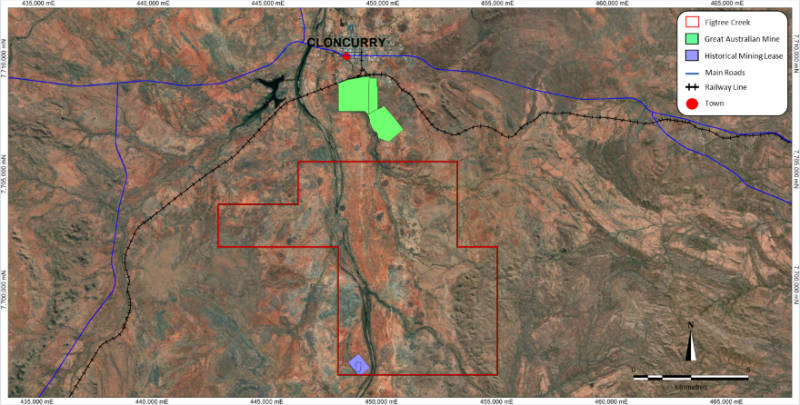Critical Minerals Group’s copper-gold projects are pretty exciting too

Critical Minerals Group's two copper-gold projects near Cloncurry are well located. Pic: via Getty Images
While the Lindfield vanadium project is certainly Critical Minerals Group’s flagship, the company is also focused on other critical mineral opportunities.
The company also holds two early-stage and utterly intriguing copper-gold projects in the Cloncurry region – just the right fit for the company’s current focus given how integral copper is becoming for the electric vehicle revolution.
Despite being located amidst numerous – current and historic – resource projects, both the Figtree Creek and Lorena Surrounds projects are exciting greenfields plays that have only seen minimal exploration.
Managing director Scott Drelincourt told Stockhead this is due to the thin alluvial cover over most, if not all of the two projects which has hindered the usual way mines around Cloncurry were found and developed.
“Historically in the region – discoveries were found along outcrops where geologists would identify minerals or veins of copper or gold and it was from these mineral rich outcrops which mines were developed.
However, CMG believe that these same mineralised systems may lie just below the alluvial cover.
Location is the key to success
The Figtree Creek project covers 70sqkm of ground located just 5km south of Cloncurry, northwest Queensland, and includes a lapsed historical mining lease that was never exploited.
Significantly, it is located near a number of advanced copper-gold projects and mines such as the Great Australian Mine (1.69Mt grading 2.29% copper and 0.23 grams per tonne gold) just 3km to the north.
Drelincourt noted that the former mining lease has similar electromagnetic and geophysical signatures to that of the Great Australian Mine.
“That’s a big indicator that a similar mineralised system may lie just below the surface. That was enough reason for us to look deeper and find surface soil anomalies of copper-gold throughout the project,” he told Stockhead.
“Also pointing to the potential of a deposit under cover is that the project has the geological structures you would expect from that region for an IOCG-style mineralisation.”
IOCG (Iron oxide copper gold) deposits can be tremendously large, high-grade, and simple-to-process concentrations of economic minerals as evidenced by the best known example, the giant Olympic Dam mine in South Australia.
“So when you put the geophysical signatures, the old mining lease, surface anomalies and geological structures all together, it creates a pretty appealing area,” Drelincourt added.

Proven copper-gold system
Just a few kms away is the Lorena Surrounds project, which consists of a 51sqkm tenement broken into three parts, just to the east of Cloncurry.
Like Figtree Creek, the project is surrounded by advanced mining projects such as Glencore’s Mt Margaret copper mine, the Lorena gold mine itself and the Great Australian Mine.
While alluvial cover is also present throughout most of Lorena Surrounds, it does differ from its compatriot in having some outcrops and three historical drill holes.
“The historical drill holes did intercept the right type of geological features and veins with some moderate to low assay grades. But they weren’t targeting areas that CMG have identified,” Drelincourt noted.
“However, they do show that the right type of mineralisation you expect to find in IOCG systems along with the right geological structural features.”
Along with the presence of some small historical workings within the project where gold outcrops were mined, this is an indication that a copper-gold system may be present.

Upcoming work program
Critical Minerals is currently waiting on the two projects to be awarded, which is currently anticipated to occur in the second quarter of this year.
Once they are granted, it will interpret the geophysical data and refine its 3D models.
“We will also be doing geological mapping on site for both projects and MMI sampling, all in the first year of the project’s granting,” Drelincourt said.
MMI (Mobile Metal Ion) sampling is a technique that detects mobile ions that may be indicative of a copper, gold or other mineral source at depth.
“It helps you gain a better understanding of what is below – what you’re sampling – so it’s a way to penetrate deeper than typical soil or rock chip sampling,” he explained.
“The second year will be a bit more desktop heavy, pulling in all that work done and interpreting that to identify the best drill targets. Maybe more sampling work as well.”
More information on these projects can be found on the company’s website https://www.criticalmineralsgroup.com.au/figtree-creek-and-lorena-surrounds-projects
This article was developed in collaboration with Critical Minerals Group, a Stockhead advertiser at the time of publishing.
This article does not constitute financial product advice. You should consider obtaining independent advice before making any financial decisions.
Related Topics
UNLOCK INSIGHTS
Discover the untold stories of emerging ASX stocks.
Daily news and expert analysis, it's free to subscribe.
By proceeding, you confirm you understand that we handle personal information in accordance with our Privacy Policy.








